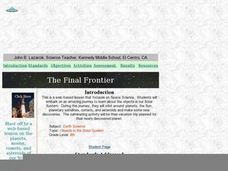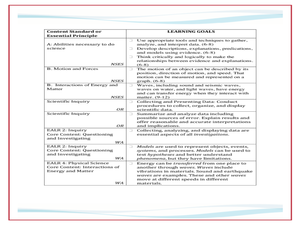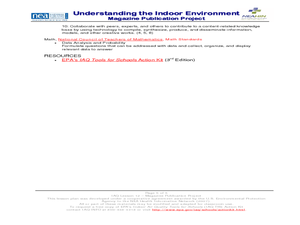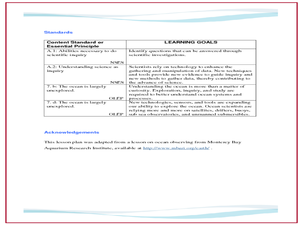Curated OER
It's Everyone's Home
Students research environmental destruction. In this cause and effect lesson, students students gain an understanding of everyday things we do to harm the environment. Students work in groups to create a brochure that tells the...
Curated OER
Analyzing Meteorological Data From Mars
Students compare real-time Earth and Mars measurements for temperature, wind speed, humidity and atmospheric pressure by accessing Internet-data resources from NASA. They access real-time weather data and maps for their school location.
Curated OER
Making the Connection With Quilts
Fourth graders engage in a lesson which integrates the study of the Underground Railroad in Indiana with a Language Arts unit on quilts. They write a book report on one of the quilt books read in class and design a quilt block for the...
Curated OER
Classroom Meteorologists: An Experiential Approach to Learning about Seasons and Weather
Students examine several concepts about weather in the seven lessons of this unit. This year long activity helps students to gather data seasonally about wind, clouds, precipitation, and temperature. Earth's three climate zones are...
Curated OER
Wales: An Interdisciplinary Unit
Students practice basic map and geographic skills as they compare Oregon to Wales. Students color map of Wales and Oregon using color codes to distinguish between land, water, and bordering nations or states, listen to stories and...
Curated OER
Planets in Our Solar System
Second graders research climate and landforms on nine planets in our solar system, choose one planet to visit, gather information about their chosen planet's climate and landforms, and "invent" space suit that would enable them to...
Curated OER
Voyage of Discovery
Students develop a sense of the scale of our solar system by creating a one to ten billion scale model. They calculate the relative sizes and distances for the planets and asteroid belt using a guiding worksheet. To create the model they...
Curated OER
Co-evolution of Plants and Pollinators
Young scholars explore biological evolution and natural selection and its evolutionary consequences. They also explore how organisms are interdependent on one another.
Curated OER
Conditions at Sea Introductory Activity, Making Waves
Students explore waves and wind. In this physical and earth science wave instructional activity, students participate in a wave making activity with an aquarium and a hair dryer. Students complete a data chart recording wave height and...
Curated OER
What Were Dinosaurs Like?
Students view a video clips about Dinosaurs. In this dinosaur instructional activity, students begin to understand the extinction of the dinosaurs by comparing them to contemporary animals. Students complete a research sheet on one...
Curated OER
I Feel Renewed!
Students participate in a simulation of the equal and unequal distribution of the earth's renewable resources. They discuss renewable resources and how food resources can increase and decrease, participate in the simulation, and analyze...
Curated OER
State Symbols of Michigan
Students study the symbols of the state of Michigan and create a slide show using KidPix. They discuss the diversity of creation within the state of Michigan. Students also discuss how God is in control of the "kings of our earth."
Curated OER
CyberHunt: Digging for Dinosaurs
Students discover dinosaur facts using internet research. In this 2nd - 3rd grade lesson plan, students identify various dinosaur facts. Students use internet research to answer questions regarding dinosaurs.
Curated OER
Biodiversity in an Estuary
Students investigate the biodiversity in estuaries. In this estuary lesson plan, students use Google Earth to explore the Rookery Bay National Estuarine Research Reserve. They produce a biodiversity concept map and portray the life of a...
Curated OER
Dinosaurs
Students participate in a simulated archeological dig to gain an understanding of the earth's development as well as the organisms on it. In this dinosaur lesson plan, students work in small groups removing five pieces from the 'dig' one...
Curated OER
Shake, Rattle, and Roll: Mt. St. Helens - Lesson Plan 2
Students compile information on volcanic activity at Mount St. Helens. In this earth science activity, students use the information they gathered on Mount St. Helens to answer questions and create charts in Excel. Then...
Curated OER
Mapping the Canyon
Students compare and contrast topographic maps and bathymetric maps. They investigate how bathymetric maps are made and how to interpret one.
Curated OER
Indoor Environment: A Magazine Publication Project
Students demonstrate knowledge of Indoor Air Quality by creating a class magazine. A link to order a free Action Kit from the U.S. Environmental Protection Agency is provided so teachers can build background knowledge. Performance...
Curated OER
Infrared-Hot
Students describe how the sun heats the Earth, explain the nature of infrared light, explain how thunderstorms are formed and use infrared maps to predict severe weather.
Curated OER
How Do Things Fall?
Students study forces by examining the force of gravitational attraction. They observe how objects fall and measure the force of gravitational attraction upon objects. Students discover that, since gravitational constants are different...
Curated OER
Ocean Observations
Students examine a coastal ocean. In this physical science/earth science activity, students generate a list of questions about how researchers study the ocean. In addition, students investigate, through research on the computer, to...
Curated OER
Severe Weather
Fifth graders identify the causes and effects of several different kinds of
severe weather phenomenon. They read an excerpt from John Muir's book The Mountains of California and research one of the following severe
weather phenomena...
Curated OER
Stellar Navigation
Middle schoolers are introduced to the concept of stellar navigation. Inside a portable digital planetarium they identify various stars that were used as a navigational tool. They go through several activities in which they attempt to...
Curated OER
Exquisite Excursions
Students locate 6 cities, one on each of the 6 major continents. They find distance for each leg of their journey, convert to percents, use a time zone map, and convert to foreign currencies.























